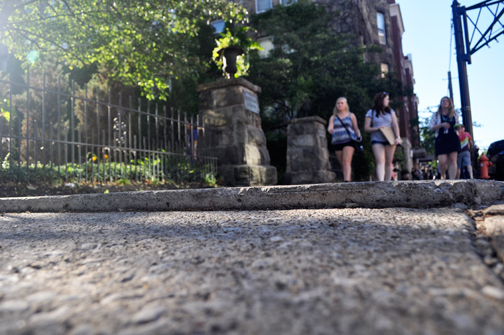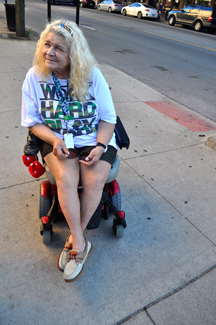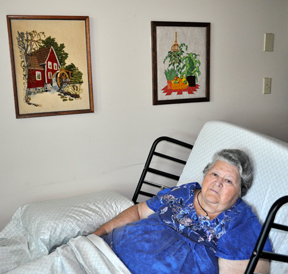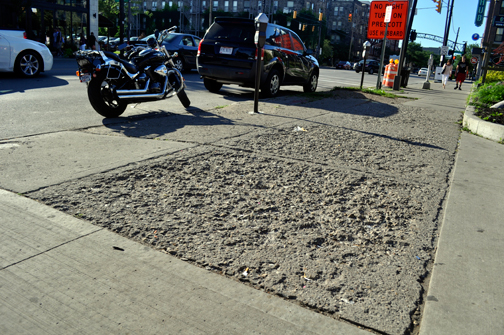
Columbus, Ohio USA
Return to Homepage www.shortnorth.com
Navigating the Urban Landscape
How accessible is the Short North for the disabled?
By Tracy Zollinger Turner
tzt@writearm.com
July/August 2015 Issue
Return to Homepage / Return to Features Index
Photos by Tracy Zollinger Turner and Lawrence J. Ruich
Carol Sagara has traveled the Short North in a wheelchair for the past decade, ever since the pain of spinal arthritis and osteoarthritis in every joint in her body began to hinder her ability to walk.
Uneven sidewalks like this in front of the Greystone building can be a dead end for wheelchairs.
A master seamstress, she sewed the tops of convertibles for Crown Auto Top, and later tuxedos downtown. She and her husband, who was in the Air Force, raised three children in Columbus. She’s lived on her own ever since he passed away in the late 1980s.
Now 77 years old, she loves her neighborhood, loves her view of the buildings and treetops from her apartment on the ninth floor of Bollinger Tower where she has lived for 21 years. She loves the building and even keeps a framed picture of it on her wall that was taken by a fellow resident. During Gallery Hop, she sometimes goes down to the High Street courtyard to listen to a singer she likes with her neighbors. She frets when bigger events prevent her nurse, who visits her daily, from being able to get through the traffic or find parking, but says she figures it’s all good for the city’s life and economy.
“I have more trouble with the sidewalks than anybody that lives here in the Short North,” says Sagara. “People are always kind and willing to help me out when I need something. You can’t get a better location than this. Broad and High Street are only six blocks away.”
Sagara can easily list a number of places on High Street where she must divert her wheelchair into the street or onto the grass due to uneven or buckling sidewalks, as well as places where the surface is broken up enough that she knows from experience that it could ruin her tires and cause several hundred dollars for repairs that she does not have.
“In some places it’s mature trees bringing up the sidewalk,” she says. “In some places the sidewalk is just broken.”
Places that most able-bodied people wouldn’t give a second thought to can be an unsurpassable obstacle for Sagara. Like two sections of sidewalk that are uneven by a couple of inches in front of the Greystone building. “
“My wheelchair just cannot go over that sidewalk,” says Sagara.
Other residents of her building, several of whom use wheelchairs, know these same obstacles well. Bollinger Tower is a 100-unit high-rise for seniors who are low income or have disabilities, named for a former director of the Columbus Metropolitan Housing Authority who later worked for the U.S. Department of Housing and Urban Development under Ronald Reagan. Buses and shuttles are accessible and come to either side of the building.
Tina says getting to the Kroger Store along High Street from Bollinger Tower is all but impossible.
Another resident named Tina, who has lived in the tower for 12 years and has heart stickers and red fuzzy dice decorating the wheelchair that she’s used for the past ten, wants to be identified by only her first name. She says that getting groceries can be problematic.
“On a nice day, getting down Buttles to the Giant Eagle is no problem,” she says. But the way up High Street to Kroger is all but impossible on either side of the street, and side streets are worse. When it snows, she says, mobility goes out the window.
“The city plows the snow straight into the curb cuts all around this building,” she says. “We can’t go anywhere.”
There are multiple obstacles and dead ends for wheelchairs in the neighborhood. High Street’s curb cuts are in decent condition, but some side street sidewalks end in curbs steep enough to endanger a person in a wheelchair, or narrow to the point of being difficult or impossible to pass. Sidewalks below First Avenue are, by and large, in better shape than those above it, although crossing brick streets like Lincoln can be painful for Sagara.
Bollinger Tower resident Carol Sagara who uses a wheelchair on the streets and sidewalks of the Short North is not happy with the obstacles she encounters but loves the neighborhood.
“It’s back jarring and there’s no way to avoid going across it,” she says. “But anywhere else to the south going downtown is quite doable.”
One of the holdups with sidewalk repair is that people often don’t know who is responsible for making them. Even advocates for the disabled don’t always know this because the laws can be different in different cities.
When I tell property owners that it’s their responsibility to get the sidewalks fixed, they say ‘no, that’s the city’s problem,” says Sagara. When she happens to get a chance to speak with someone, they usually respond “very negatively” about it, she says.
In fact, the city of Columbus website says that property and business owners are the ones responsible for the maintenance of sidewalks – their condition as well as snow and ice removal. (They can be reported through the city’s 311 call center at 614-645-3111 or by emailing 311@columbus.gov.) If trees planted by the city are the source of the problem, that should be reported as well.
“If it’s a street tree Rec and Parks would come out and look at it, see about repairing it,” says Rick Tilton of the Columbus Department of Public Service.
The city website estimates that between 50 and 60 percent of Columbus is uncurbed and without sidewalks, particularly in older neighborhoods that were built when installing sidewalks was not a common practice. All new developments require them.
*****
According to the Census Bureau, 19 percent, nearly one in five people in the U.S., has a disability. July marks the 25th anniversary of the Americans with Disabilities Act, which will be celebrated at Columbus Commons on July 23 with exhibitors and the ADA Legacy Tour Bus, which contains exhibits about the history of the disability civil rights movement.
The ADA created a mandate to end discrimination against people with physical and mental disabilities that has changed the way that new public spaces are built and many older buildings are maintained or upgraded. While 25 years may seem like a long time for such laws to take root, there are still a lot of challenges.
Rough sidewalks mean a bumpy ride near La Fogata Grill. “People with disabilities should be fully integrated in our communities and be able to live lives just like people without disabilities,” says Kevin Truitt, the attorney who leads the Community Integration team for Disability Rights Ohio and resides in the Short North. “Our neighborhood should be inclusive and diverse.”
As one of the city’s primary tourist attractions, just how accessible is the Short North? Beyond the problems with mobility on its sidewalks, a number of buildings were constructed before 1990, before doorways wide enough for wheelchairs or ramps were a requirement; so many obstacles to full integration still exist.
“For these older buildings, if there’s a physical barrier that would keep a person from entering a public space, they must remove it if it is readily achievable to do so,” says Truitt.
While some in the neighborhood struggle with the new developments that are filling in every open space on High Street, these places do open up new options for the physically disabled that can be welcoming to a diverse community.
“There are really specific technical standards for a building that is to be constructed,” says Truitt. “There’s a lot of new development in the Short North and those buildings have to comply, so that’s a good thing.”
For people with visual or hearing impairments, the Short North seems to be a decent place to visit. The audio pedestrian signals that are crucial to the blind are common at traffic lights, and curb cuts along High Street appear to have tactile warning strips for blind people who use a cane.
“Having clear definitions of where the sidewalk ends and the street begins is essential,” says Mary Hiland, who is blind, and a member of the mayor’s Advisory Committee on Disability Issues. “The city has done a lot of remodeling of the corners, but when they are too flat, we can find ourselves in the street.”
Some of the challenges of navigating in the Short North are the same that one might experience in any other urban landscape. COTA, which was sued by two blind citizens for not adhering to the ADA standard of announcing all stops in 2011, now has an employee designated for ADA compliance.
According to Truitt, Disability Rights Ohio gets its largest number of calls about businesses refusing people with service animals. Ride-sharing services Uber and Lyft are facing lawsuits all over the country because of drivers’ refusal to serve people with guide dogs or wheelchairs.
“Things have gotten a lot better,” says Hiland. “I never get turned away from a restaurant with my guide dog these days. I used to. The biggest problem I have is that my guide dog is too darn cute and people want to pet her. It’s very important for people to know that guide dogs need to concentrate on their handler and not on the public.”
Public spaces having met the mandate for railings and wide stalls in bathrooms but failing to provide ramps for wheelchairs is another common problem.
For the hearing impaired, technology has opened up a lot of new vistas in recent years. Video conferencing on smart phones can assist them with communication or the location of interpreting services.
“There are communication issues, but there are also attitudinal issues we can face, like people expecting us to read lips or speak,” says John Moore, CEO and executive director of the Deaf Services Center. “Sometimes there’s a degree of awkwardness. Most of the time the challenges are communication related. For example, if a person comes up from behind and starts speaking, sometimes I don’t realize someone is behind me. If you go to order at a restaurant you have to do a lot of pointing or maybe writing down messages and sometimes hearing people aren’t comfortable with that.”
He does see a growing number of local people taking American Sign Language – 1,500 in the past five years through his service, which is hopefully a signal of changing attitudes.
Some disability advocates argue that most of us are only temporarily able-bodied – that at some point, if we live long enough, we will require some form of assistance to complete essential daily tasks. Whether one buys into that notion or not, walking High and its side streets while considering how moving through it with a wheelchair or walker would work is illuminating, as is considering the experience of people with hearing or visual impairments.
In certain areas above Third Avenue, it didn’t take long to witness an able-bodied person trip over an uneven sidewalk. The combination of railings and cracked sidewalks and the bus stop in front of the Family Dollar make a walking person turn his or her body in such a way that it’s already an obstacle course for a person without a wheelchair. Even seemingly innocuous things on the better-kept sidewalks, like sandwich boards with advertising, can effectively force a person in a wheelchair to move into the street.
The more you look, the more the question becomes one of whether you wait for someone more directly affected by something like a broken sidewalk to report or talk to business owners about it or do what you can to make the space welcoming to all.
This article was reported with support form Puffin Foundation West, Ltd. © 2015 Short North Gazette, Columbus, Ohio. All rights reserved.
Return to Homepage www.shortnorth.com




